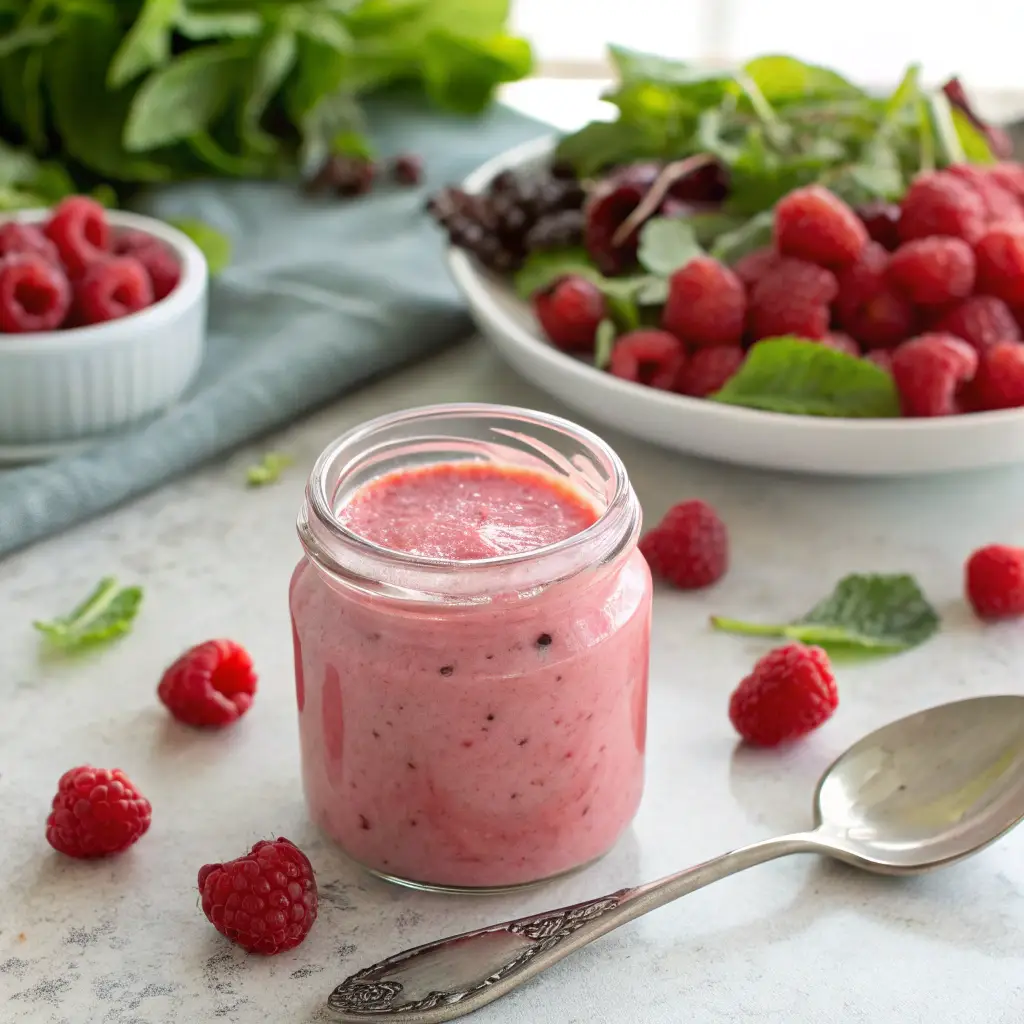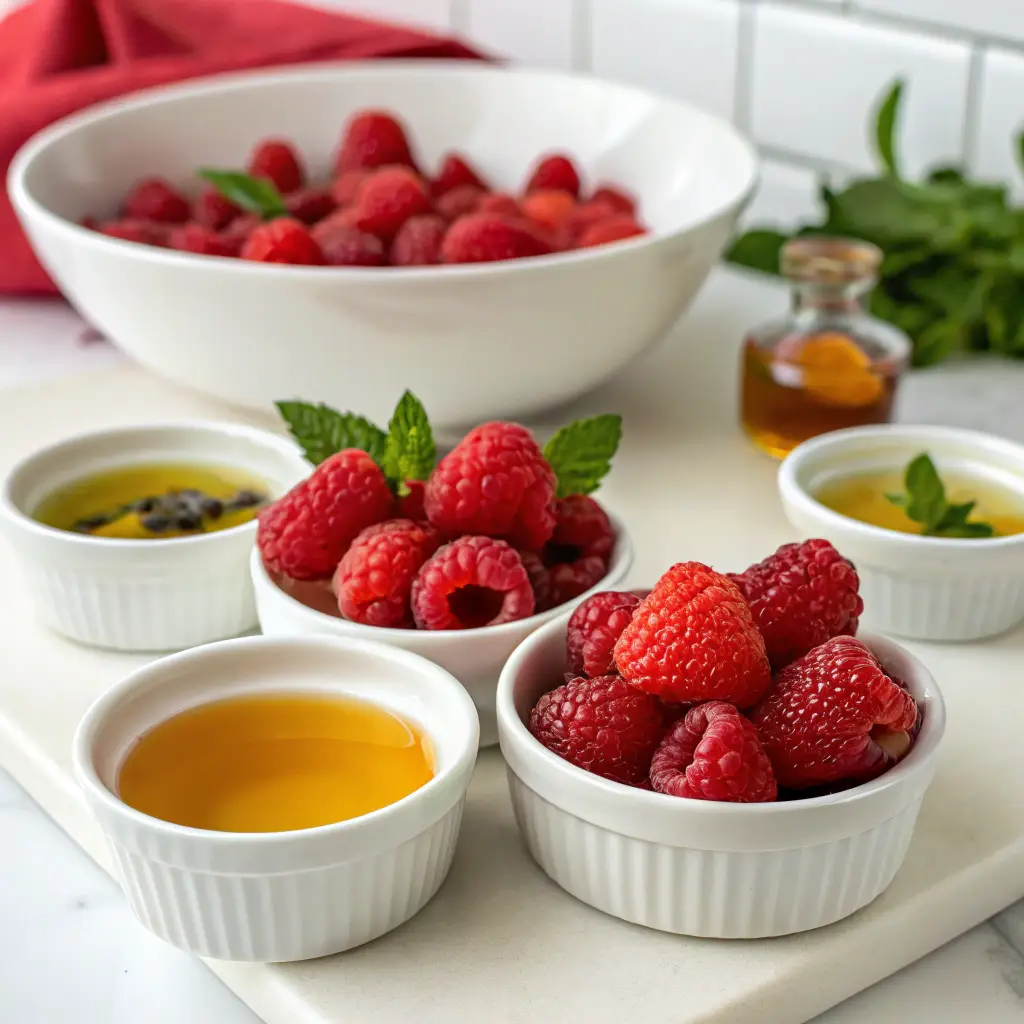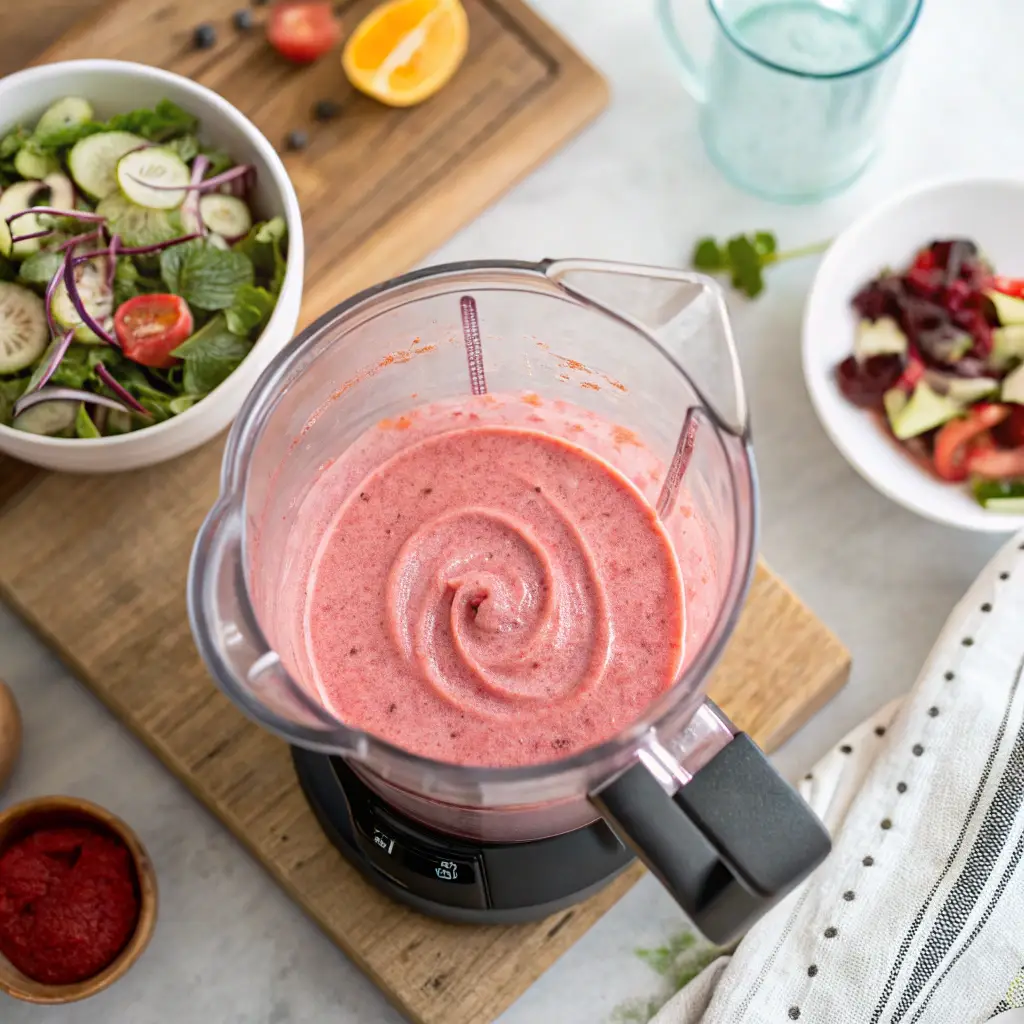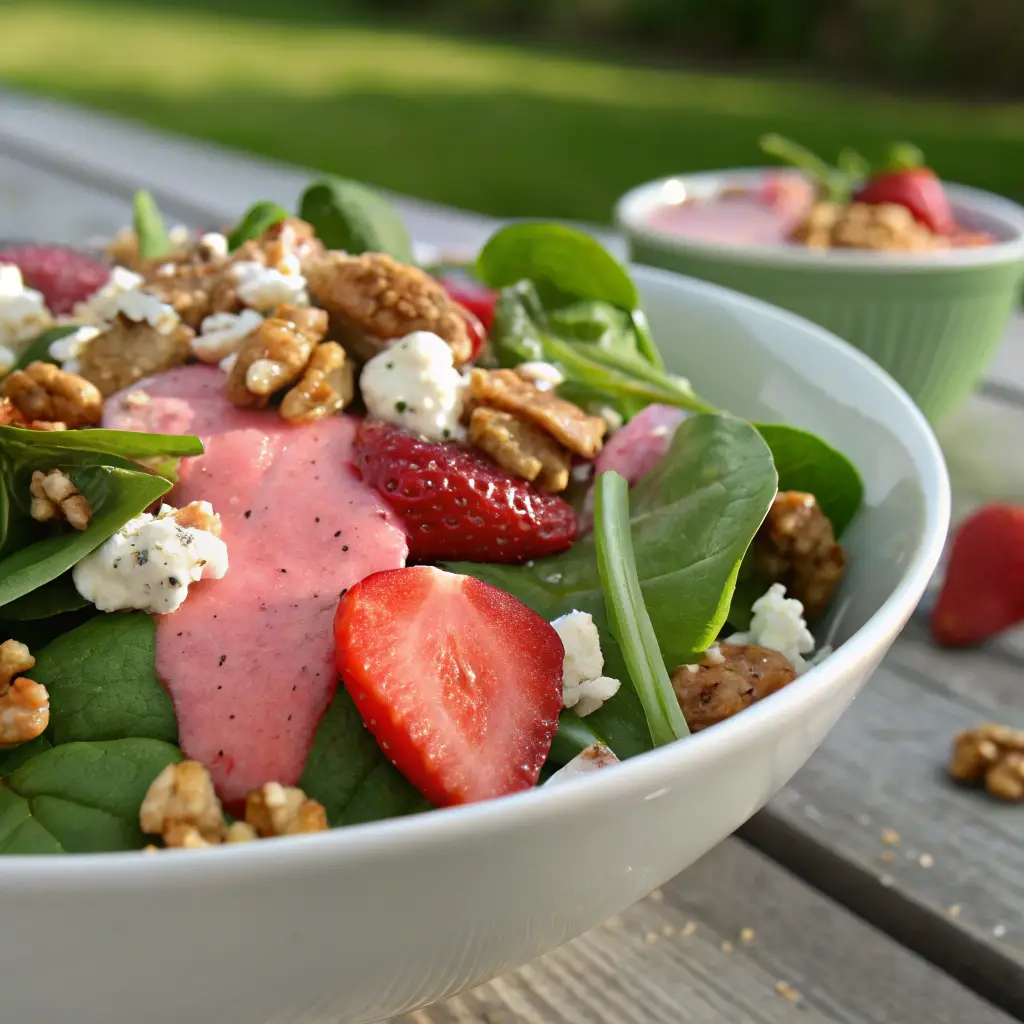Pink Salad Dressing is more than just a pretty splash of color on your greens—it’s a deliciously tangy, fruity, and vibrant homemade dressing that’s perfect for elevating everyday meals. Whether you’re crafting a summer salad or looking to impress with a unique vinaigrette, this berry-powered dressing offers the perfect balance of flavor and freshness.
Made primarily with raspberries, raspberry vinegar, and extra virgin olive oil, this dressing brings a burst of sweet-tart taste along with natural antioxidants. You can adjust its creaminess with Dijon mustard or dial up the flavor with shallots or red onions. It’s a clean, wholesome alternative to bottled dressings—and it looks gorgeous too.
Discover great ideas like this Italian Pink Sauce Recipe if you’re craving even more pink-inspired creations.
In this complete guide, we’ll walk you through every step—from the key ingredients to expert preparation tips and flavor variations. Ready to dive in?
Table of contents
Table of contents
What is Pink Salad Dressing?
Origin and Popularity of Pink Salad Dressing
Pink salad dressing isn’t a new invention—it’s just been hiding under names like raspberry vinaigrette or berry-infused dressing. Its roots can be traced to French-style vinaigrettes and later, American adaptations using berries for natural color and sweetness. The visual appeal of the pink hue quickly made it a staple at garden parties and health-focused cafes, often featured alongside fresh greens and summer produce.
Across the U.S., especially in California and the Pacific Northwest, pink salad dressings have gained a loyal following. Their popularity stems not just from looks, but also their light, fruity profile that complements a variety of leafy greens and even grains like quinoa.
Common Ingredients That Give It the Signature Pink Color
The vibrant pink hue doesn’t come from food coloring (at least, not when it’s homemade). The key ingredient is fresh or frozen raspberries. These berries bleed color naturally into the vinaigrette mixture, creating that eye-catching tone.
Other contributors to the color can include:
- Raspberry vinegar, which has a red hue itself
- Red onions or shallots, if blended in fine amounts
- Strawberries, when used as a substitute for raspberries
Interestingly, commercial versions may include beet juice or artificial dyes, but we’re focusing on fresh, wholesome ingredients that you can trust and pronounce.

Pink Salad Dressing: The Ultimate Guide to a Flavorful, Vibrant Homemade Recipe
Ingredients
Method
- 1. In a blender or small food processor, combine raspberries, vinegar, shallot, and mustard.
- 2. Blend until smooth.
- 3. With the blender running, slowly drizzle in the olive oil until emulsified.
- 4. Taste and season with salt and pepper.
- 5. Transfer to a jar and refrigerate for at least 30 minutes before using.
Nutrition
Notes
Tried this recipe?
Let us know how it was!Key Ingredients for the Perfect Pink Salad Dressing

Why Extra Virgin Olive Oil is a Must for Flavor and Health
If you want your pink salad dressing to taste like more than just sweet fruit syrup, start with extra virgin olive oil. It adds richness, depth, and body to the vinaigrette—something cheap oils like soybean or canola can’t provide. Olive oil also helps emulsify the mixture, giving your dressing that smooth, velvety texture that clings perfectly to leafy greens.
Not to mention, olive oil is a nutritional powerhouse. It’s packed with heart-healthy monounsaturated fats and antioxidants, which makes your dressing not only tastier but also better for you.
| Feature | Extra Virgin Olive Oil | Other Oils (Canola/Soybean) |
|---|---|---|
| Flavor Profile | Rich, peppery, bold | Bland or slightly nutty |
| Health Benefits | High in antioxidants | Often refined and processed |
| Texture Contribution | Emulsifies naturally | Can separate easily |
| Ideal for Salad Dressing? | Absolutely | Not recommended |
Always opt for cold-pressed, unfiltered varieties for the best taste and aroma. This single swap can elevate your homemade pink salad dressing from basic to brilliant.
Choosing the right vinegar ensures your pink salad dressing doesn’t just look good—it tastes phenomenal.
Best Fruit Options for a Pink Hue
Fresh vs. Frozen Raspberries: Texture and Taste Explained
When it comes to achieving that signature pink hue and punchy berry flavor, fresh raspberries are your best friend. They blend smoothly, taste bright, and bring a light seed texture that adds authenticity to homemade pink salad dressing. However, when raspberries are out of season, frozen raspberries are a worthy backup.
The main difference lies in texture and consistency. Frozen raspberries can be slightly mushier once thawed, but when blended properly, they deliver the same vibrant color and a comparable flavor profile. Just remember to fully thaw and drain them before use to avoid a watery dressing.
| Feature | Fresh Raspberries | Frozen Raspberries |
|---|---|---|
| Color Intensity | Bright and natural | Slightly darker but vibrant |
| Flavor Quality | Fresh, crisp, aromatic | Slightly muted when thawed |
| Texture in Dressing | Slightly pulpy | Smoother if well blended |
| Best Used When | In season, locally sourced | Out of season or bulk prep |
If neither option is available, strawberries come in as a strong substitute.
Strawberries as a Substitute: When and How to Use Them
Strawberries can step in to replace raspberries in pink salad dressing without drastically changing the character of the recipe. They have a sweeter profile and are less tart, which means you may want to slightly increase the acid (like vinegar or lemon juice) to maintain balance.
Opt for ripe, red strawberries, remove the stems, and blend until smooth. You can also combine strawberries and raspberries for a more complex fruity taste and a smoother pink tone.
Here’s how strawberries compare to raspberries for this dressing:
| Attribute | Raspberries | Strawberries |
|---|---|---|
| Color Output | Deep pink to red | Soft pink |
| Flavor | Tangy, sharp | Sweet, mellow |
| Texture | Slightly seedy | Silky, smoother |
| Acid Adjustment | Not needed | May require more vinegar |
So whether you’re working with a farmer’s market bounty or a freezer stash, you can make an amazing pink salad dressing using the right berry blend.
Flavor Boosters That Matter
Dijon Mustard for Texture and Emulsion
One of the most overlooked, yet essential components in pink salad dressing is Dijon mustard. Not only does it bring a subtle sharpness that balances the sweetness of the berries, but it also acts as an emulsifier. This means it helps bind oil and vinegar together, creating a smooth, creamy texture that doesn’t separate after a few minutes.
Dijon mustard works well with berry-based dressings because it has a mild heat that doesn’t overpower fruit flavors. A teaspoon or two is usually enough to enhance the structure and round out the taste. Avoid yellow mustard, as it’s too bold and can throw off the balance.
Here’s what Dijon brings to your dressing:
- Creaminess without dairy
- Balanced sharpness
- Longer-lasting consistency
- Smooth mouthfeel
For a slightly sweeter profile, you can mix Dijon with a drop of honey or maple syrup—but sparingly, as the berries already provide sweetness.
How Shallots and Red Onions Elevate the Taste
A small shallot or a piece of red onion can take your pink salad dressing from fruity to gourmet. Shallots add a mild, sweet onion flavor that blends easily and doesn’t dominate the dressing. If you don’t have shallots on hand, a small sliver of red onion does the job. Just make sure to blend it finely so it doesn’t overpower the delicate fruit tones.
This tiny ingredient brings dimension to your dressing, especially if you’re using it on heartier salads like arugula, spinach, or grain bowls.
Here’s how the two compare in dressings:
| Ingredient | Flavor Profile | Best Use |
|---|---|---|
| Shallot | Mild, sweet, aromatic | For subtle depth |
| Red Onion | Sharp, crisp | For bolder, punchier versions |
To mellow the onion taste, soak chopped red onion in cold water for 10 minutes before blending.
Both options add complexity and balance, helping your dressing stand out with just a touch of savory undertone.
Step-by-Step: How to Make Pink Salad Dressing at Home

Basic Method for Smooth, Creamy Consistency
Making homemade pink salad dressing is simple, fast, and totally customizable. Whether you’re using fresh raspberries or thawed frozen ones, the key is blending the ingredients until you reach a velvety consistency.
Here’s a step-by-step method to make about 1 cup of dressing:
Ingredients:
- ½ cup fresh or thawed frozen raspberries
- ¼ cup raspberry vinegar
- 1 tsp Dijon mustard
- ⅓ cup extra virgin olive oil
- 1 small shallot (optional)
- Salt and black pepper to taste
Directions:
- Blend the base: Add raspberries, vinegar, and Dijon mustard to a blender or food processor.
- Add flavor: Toss in the shallot or red onion if using. Blend until smooth.
- Emulsify: Slowly drizzle in olive oil while blending to create a creamy, well-emulsified dressing.
- Season: Add salt and pepper to taste. Blend one more time for a final mix.
- Strain (optional): For a silky texture, pour the dressing through a fine mesh strainer to remove seeds.
You now have a smooth, vibrant pink dressing perfect for drizzling over greens, grain bowls, or even roasted veggies.
Pro Tips for Balancing Tanginess and Sweetness
- Too tangy? Add a tiny drizzle of honey or a ripe strawberry to mellow the acidity.
- Too thick? Mix in a teaspoon of cold water or lemon juice to thin it out.
- Too bland? Try a pinch more salt or a few cracks of fresh black pepper.
- Too sweet? Up the Dijon or vinegar to cut through the sweetness.
Keep in mind that flavors develop after sitting—let the dressing chill in the fridge for 30 minutes before serving for best results.
| Adjustment Needed | Quick Fix |
|---|---|
| More Sweetness | Add honey or ripe strawberry |
| More Tang | Increase vinegar or mustard |
| Too Thick | Add lemon juice or water |
| Needs Depth | Add a dash of balsamic or herbs |
Serving Ideas and Pairings

Best Salads to Pair with Pink Salad Dressing
Pink salad dressing shines brightest when paired with light, fresh ingredients that allow its sweet-tangy profile to stand out. Here are some of the best salad combinations where this raspberry vinaigrette truly steals the show:
1. Mixed Greens with Goat Cheese and Walnuts
The creamy tang of goat cheese paired with crunchy walnuts and peppery arugula makes the perfect base for the fruity pink dressing.
2. Spinach, Strawberry, and Almond Salad
This classic sweet salad complements the berry dressing with matching fruit tones. The almonds add texture, while the spinach keeps things earthy and green.
3. Quinoa Salad with Cucumber and Feta
The raspberry vinegar and Dijon mustard bring a light sharpness that contrasts beautifully with mild quinoa and salty feta.
4. Kale and Apple Salad
Kale benefits from a fruit-forward dressing, and crisp apple slices play up the sweetness of the raspberries.
| Salad Type | Pairing Notes |
|---|---|
| Mixed greens + goat cheese | Tangy cheese softens the fruity intensity |
| Spinach + strawberries | Doubles down on berry flavors, perfect for summer |
| Quinoa + cucumber + feta | Adds structure, protein, and a Mediterranean vibe |
| Kale + apples + pecans | Perfect for fall, with hearty textures and crunch |
Other Dishes That Shine with This Dressing
Pink salad dressing isn’t limited to just leafy bowls. Its sweet, tart, and savory balance makes it a surprisingly versatile addition to a variety of dishes:
- Grilled Chicken or Turkey: Use it as a glaze or drizzle over sliced cuts for a zesty twist.
- Grain Bowls: Pour over farro, bulgur, or couscous bowls with veggies for added moisture and flavor.
- Roasted Root Vegetables: Drizzle over roasted beets, carrots, or sweet potatoes after baking.
- Cheese Boards: Serve in a small ramekin as a fruity dip for hard cheeses like manchego or aged cheddar.
Looking for inspiration? Try this Italian pink sauce recipe to explore other creative uses of pink sauces beyond dressings.
This versatility makes pink salad dressing a true star in your fridge.
Health Benefits and Nutritional Overview
Is Pink Salad Dressing Healthy? A Nutrition Breakdown
Yes—pink salad dressing made at home can be both nutritious and flavorful, especially when compared to store-bought dressings loaded with preservatives, sugar, and poor-quality oils. Let’s break it down by key components:
| Ingredient | Benefit |
|---|---|
| Extra Virgin Olive Oil | Heart-healthy fats, antioxidants, supports digestion |
| Raspberries | High in fiber, vitamin C, and natural antioxidants |
| Raspberry Vinegar | Supports digestion, low in calories |
| Dijon Mustard | Contains turmeric and vinegar, low-calorie thickener |
| Shallots/Red Onion | Natural prebiotics, adds flavor with little sugar |
Together, these ingredients create a light, plant-based dressing free from trans fats, stabilizers, or artificial dyes. Each tablespoon contains roughly 45–60 calories, depending on oil content, and almost no added sugar if made without honey.
Why Homemade is Better than Store-Bought Versions
When you make pink salad dressing yourself, you control everything—from the oil quality to the sweetness level. Here’s why it’s a smart move:
1. Cleaner Ingredients
Commercial dressings often sneak in sugar, artificial colors, stabilizers (like xanthan gum), and low-grade oils to extend shelf life. Homemade versions rely on real food ingredients.
2. Better Nutrition Balance
Using fresh fruit and healthy fat provides more vitamins and fiber without unnecessary additives. Homemade dressings offer real nutritional value.
3. Customizable Flavors
Don’t like it too sweet? Skip the sweeteners. Want more tang? Add lemon juice. You’re in control every step of the way.
| Feature | Store-Bought | Homemade Pink Dressing |
|---|---|---|
| Oil Type | Soybean/Canola (refined) | Extra Virgin Olive Oil |
| Preservatives | Common | None |
| Sugar Content | Often high | Optional |
| Artificial Colors | Sometimes added | None |
| Cost Per Serving | Higher | More economical |
By switching to homemade pink salad dressing, you’re not just saving money—you’re upgrading your meals with cleaner, tastier nutrition.
Storage and Shelf Life Tips
How Long Does Homemade Pink Dressing Last?
Homemade pink salad dressing—free of artificial preservatives—has a shorter shelf life than store-bought options, but it still keeps well with proper handling. When stored in an airtight container in the refrigerator, your dressing should last up to 5–7 days.
Here are key signs that your dressing is still good:
- It maintains its creamy texture
- The smell remains fresh and slightly tangy
- There’s no visible separation or bubbling
If the mixture smells sour or develops an off-color or chunky texture, it’s time to toss it.
| Storage Factor | Recommendation |
|---|---|
| Container Type | Glass jar with tight-seal lid |
| Temperature | Refrigerated at or below 40°F (4°C) |
| Shelf Life | 5–7 days |
| Shake Before Use? | Yes – natural separation may occur |
Proper Containers and Refrigeration Methods
The key to extending the life of your dressing is storing it the right way. Glass containers are best because they don’t absorb oils or odors, and they’re easy to clean.
Top Storage Tips:
- Use a mason jar, swing-top bottle, or reusable glass dressing container with a seal-tight cap.
- Label the container with the date prepared so you can keep track.
- Store it on a refrigerator shelf (not the door) to maintain consistent temperature.
- Always use a clean spoon or pour directly to avoid cross-contamination.
Avoid storing the dressing at room temperature or freezing it. The texture and emulsion can break when thawed, especially due to the oil and mustard blend.
For batch prep, consider halving the recipe unless you’re serving a crowd within a few days.
Common Variations and Customizations
Greek-Inspired Pink Dressing: Ingredients and Flavors
If you’re drawn to Mediterranean flavors, transforming your pink salad dressing into a Greek-style vinaigrette is a refreshing twist. This version still uses raspberries or strawberries for the pink hue but leans on bolder herbs and tangier acids to mimic traditional Greek profiles.
What to Add for a Greek Spin:
- Oregano (dried or fresh): Adds an earthy, herbaceous tone
- soda : Replaces raspberry vinegar for more acidity
- Crumbled feta: Blend in for a creamy, tangy variation
- Garlic clove: One small clove, finely minced or blended
This variation pairs beautifully with Greek salads, olives, cucumbers, and grilled meats. The result? A vinaigrette that’s both sweet and savory, and perfectly Mediterranean.
Spicy, Creamy, or Sweet? Adjusting to Your Taste
The beauty of pink salad dressing is that it’s highly adaptable. Whether you want more heat, creaminess, or a sweeter finish, these easy modifications will give you the flavor profile you’re after.
For a Spicy Kick:
- Add a pinch of crushed red pepper flakes
- Include a slice of jalapeño or a dash of hot sauce
- Pair with bolder greens like arugula or mustard greens
For More Creaminess:
- Blend in Greek yogurt or light sour cream
- Use avocado oil mayo for a richer texture
- Add a spoonful of cashew cream for a vegan alternative
For a Sweeter Finish:
- A teaspoon of honey or maple syrup enhances fruitiness
- Use ripe strawberries along with raspberries
- Opt for a touch of balsamic reduction for both depth and sweetness
| Desired Flavor | Ingredient Additions |
|---|---|
| Spicy | Red pepper flakes, jalapeño, hot sauce |
| Creamy | Greek yogurt, sour cream, cashew cream |
| Sweet | Honey, strawberries, balsamic glaze |
| Herbal (Greek) | Oregano, garlic |
FAQs About Pink Salad Dressing
What is pink stuff salad dressing?
Pink stuff salad dressing is a sweet and tangy dressing made primarily from berries (usually raspberries), vinegar, and olive oil, giving it a vibrant pink hue. Some versions may also include yogurt or mayo for creaminess, and Dijon mustard for emulsion. It’s often referred to as raspberry vinaigrette and used on mixed greens, spinach salads, and even grilled meats or grain bowls.
Why are some Greek dressings pink?
Some Greek dressings appear pink due to the addition of finely chopped red onions blended into the mixture. Occasionally, ingredients like pomegranate molasses or beets are added for natural color. While traditional Greek dressing is usually herby and vinegar-forward, modern pink versions blend those flavors with berry juice or fruit-infused vinegar to create a colorful twist.
What’s the unhealthiest salad dressing?
The unhealthiest salad dressings are typically store-bought options that are high in saturated fat, added sugar, and preservatives. Examples include creamy ranch, blue cheese, and some “low-fat” dressings that compensate with sugar and artificial thickeners. Choosing a homemade dressing—like pink salad dressing made with olive oil and fresh berries—keeps your meal clean, fresh, and full of real nutrition.
What is in pink salad?
Pink salad usually refers to a type of fruit salad or dessert salad made with whipped topping, gelatin, fruit (like cherries, strawberries, or pineapple), and sometimes cottage cheese or marshmallows. It’s often seen at potlucks or family gatherings. This differs from pink salad dressing, which is a vinaigrette used as a savory topping for vegetable-based salads.
Conclusion
Pink salad dressing is a beautiful, flavorful addition to your kitchen that not only looks stunning but also brings layers of sweet, tangy, and savory notes to your dishes. Whether you’re tossing it with baby greens, drizzling it over grilled chicken, or using it as a dip on a cheese board, this berry-infused dressing is versatile, healthy, and easy to make.
By using high-quality ingredients like extra virgin olive oil, raspberry vinegar, and fresh or frozen raspberries, you get all the benefits of natural nutrients without any preservatives, additives, or unnecessary sugars. Plus, with endless customization options—from Greek-style to spicy or creamy—you’ll never get bored.
Don’t miss our homepage full of recipe inspirations and explore other bold sauces like this Italian Pink Sauce Recipe to expand your pink-colored culinary game.
Discover great content like this and more pink-hued recipes on our official Facebook page—where flavor meets creativity every day.
